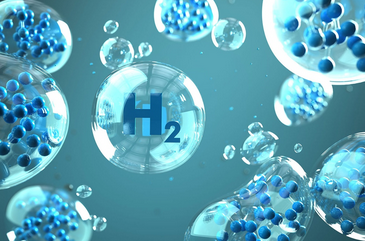Norway has huge potential to become a leader in green marine fuels.
If the shipping industry is to meet the IMO targets for emissions reduction, more vessels will have to run on alternative fuels that are sustainable, such as hydrogen and ammonia. Norwegian business clusters are taking matters into their own hands to create the necessary infrastructure and value chains for these new green marine fuels.
Ocean Hyway Cluster, a cluster focusing strongly on maritime hydrogen, and its project partners have mapped ferry and high-speed boat routes, shipping routes and offshore traffic along the Norwegian coastline that cannot be covered by battery-powered ferries – but can be covered by hydrogen vessels.
They have given the authorities and players in the maritime sector a detailed roadmap of where and how infrastructure for hydrogen and ammonia should be built.
Significant maritime decarbonisation
“Our calculations show that we can reduce carbon emissions by 1.17 million metric tons by replacing vessels that run on fuel oil and natural gas with vessels powered by hydrogen and ammonia along the Norwegian coastline,” says Svardal.
Both hydrogen and ammonia can be entirely emission-free fuels. The way they are produced determines their total carbon footprint. The two fuels are related, as ammonia is hydrogen in a chemically bound form. Nevertheless, they have somewhat different properties and application areas.
As regards ammonia, another important factor is that there are already well-developed and scaled value chains for production and transport in place. This is because in addition to being an excellent alternative fuel source, ammonia is one of the most important raw materials for manufacturing fertiliser.
“We already have enough knowledge to build the vessels we need. If the shipyard Brødrene AA, for example, receives an order for a hydrogen vessel, it will be launched 36 months later,” Svardal says.
The zero-emission Aero40 H2 fast ferry from Brødrene AA can cover longer routes than battery-powered ferries.
Ammonia as a marine fuel
To pick up the pace of maritime decarbonisation, the business cluster Maritime CleanTech is participating in and coordinating the EU-funded ShipFC project, which will install the world’s first high-power ammonia fuel cell on a vessel.
“Solid oxide fuel cells powered by ammonia will be retrofitted on the offshore support vessel Viking Energy. The vessel will be in operation for Equinor, and we hope to demonstrate that large, energy-intensive vessels can also be emission-free. This is how we will pave the way for the use of ammonia in larger vessels sailing acrosslonger distances,” says Hege Økland, CEO of Maritime CleanTech (Editor’s note: Ms Økland left her post in October 2022 and is now CEO of the hydrogen company Hy2gen Norway AS).
The ammonia fuel cell system will have a capacity of 2 MW and the aim is for the vessel to operate on the fuel cells for at least 3 000 hours during a 12-month trial period. Project partners include the Norwegian companies Alma Clean Power, Eidesvik Offshore, Equinor, Wärtsilä Norway and Yara International, as well as other Norwegian and European shipping companies, research institutions and industry players.
Hydrogen-powered vessels
In parallel, Maritime CleanTech is participating in the Value Chain for Green Liquid Hydrogen project, which is funded under Norway’s PILOT-E scheme. The project aims to build a complete liquid hydrogen supply chain in Norway for maritime applications. It is led by BKK, a Norwegian grid company and provider of energy solutions, with Equinor and the French company Air Liquide as key partners.
“Liquid hydrogen is a technically challenging energy carrier. For example, it must be stored at a temperature of -266 °C. This poses challenges for transport, storage, bunkering and fuelling. But we have tremendous expertise and experience from LNG that we can use in devising solutions,” says Hege Økland.
Ocean Hyway Cluster is running its own project, Hydrogen Infrastructure in the Maritime Industry (HyInfra), which focuses on compressed hydrogen, liquid hydrogen and ammonia.
“We have obtained a figure for how many metric tons of hydrogen we may need in Norway. We’ve dived all the way down to the timetable level to find out where hydrogen-powered vessels can be used, not counting the routes that can be covered by battery-powered ferries. Thus far, our analyses show a demand for 39 000 metric tons of hydrogen by 2035,” says Kristin Svardal.
“You have to use a calculator to calculate which fuel is most suitable for a given operation and ship operational profile. For example, ammonia has higher energy density, so you can get more energy than from hydrogen on larger vessels that sail longer distances. But in cases where weight is important, such as for high-speed vessels, hydrogen may be the most suitable fuel,” explains Økland.
She stresses that these are only a few of many factors taken into consideration when choosing a fuel.
Towards a zero-emission society
“The technology is not actually the greatest challenge, even though there is still a way to go. We will manage to build boats that run on green fuels. The challenges are commercial in nature and involve changing structures and systems,” says Økland.
Both she and Svardal believe that Norway has a unique opportunity to build a sustainable and lucrative industry around hydrogen and ammonia as fuel sources. But there are still major challenges when it comes to scaling green fuels.
“We have a long way to go before they become a standard product, in terms of developing vessel components and the fuels themselves,” Ocean Hyway Cluster’s Svardal points out, before concluding with a challenge:
“We’ve said we’re working towards a zero-emission society – but technology development is costly. We therefore need active policies with proactive strategies, such as allocating financial support and using public procurement muscle. We need stronger instruments to create and scale up markets for hydrogen and ammonia to make them profitable for the shipping industry.”
www.hannovermesse.de


 Deutsch (Germany)
Deutsch (Germany)  Polski (PL)
Polski (PL) 





